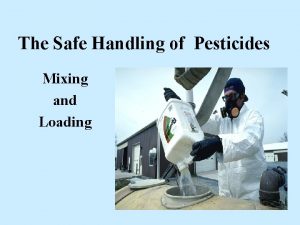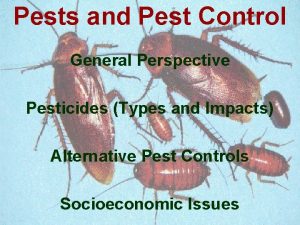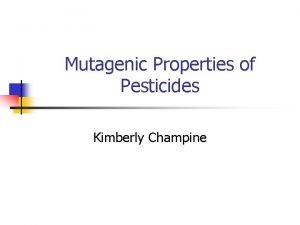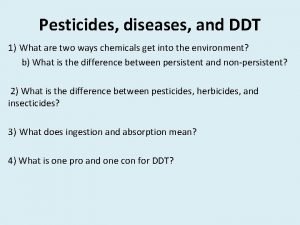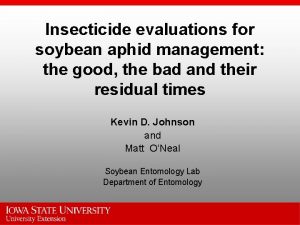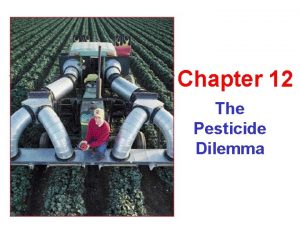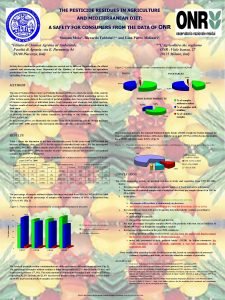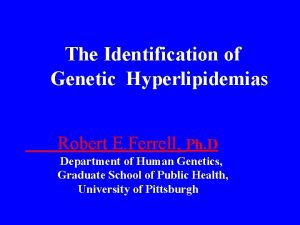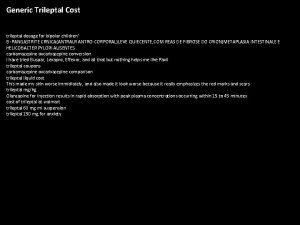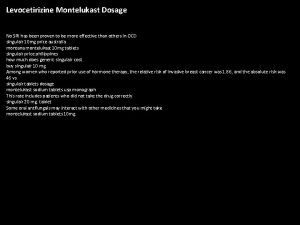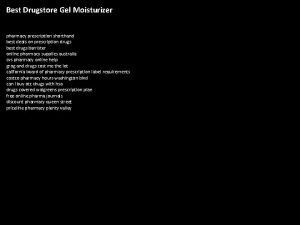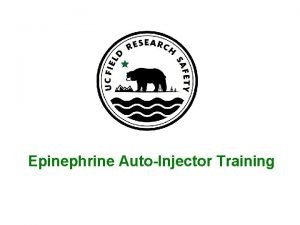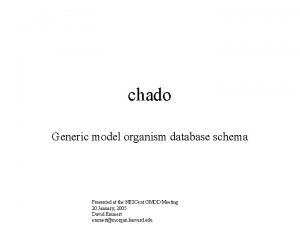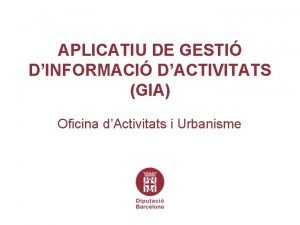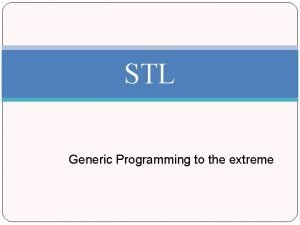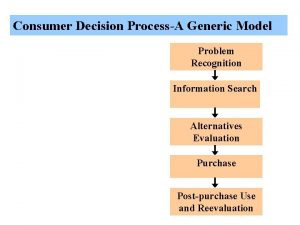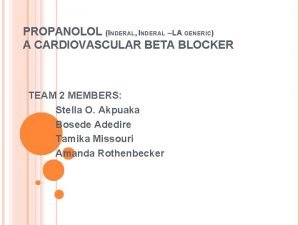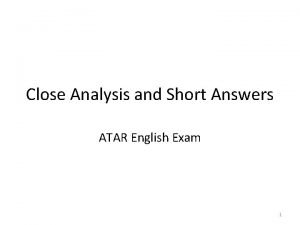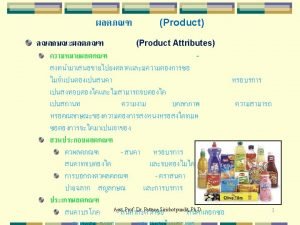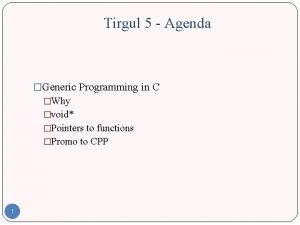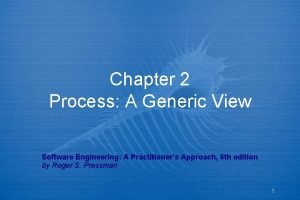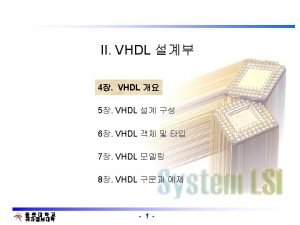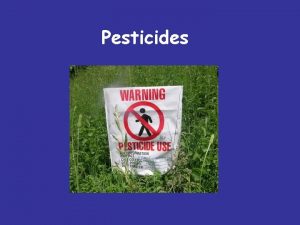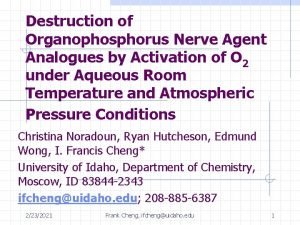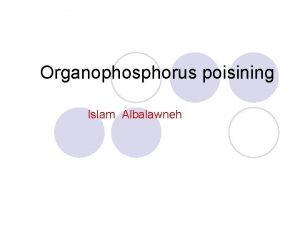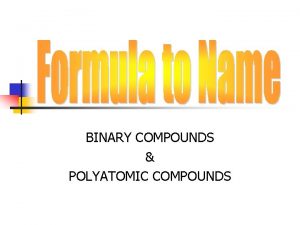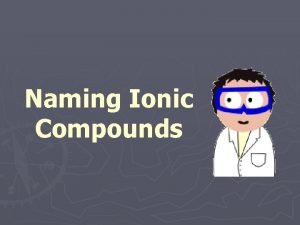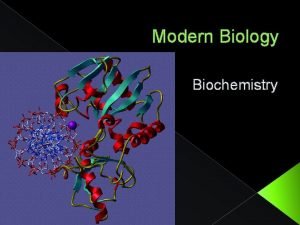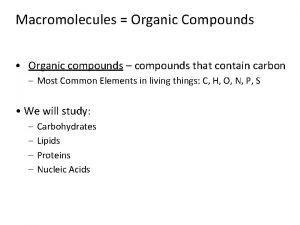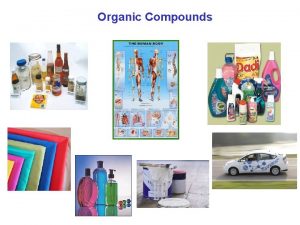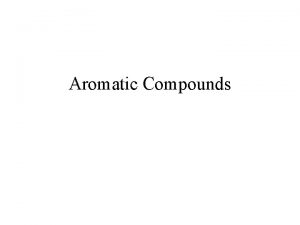Pesticides Organophosphorus compounds PERSPECTIVE Pesticides a generic term
































































































































- Slides: 128

Pesticides/ Organophosphorus compounds

PERSPECTIVE Pesticides, a generic term used to refer to all pest-killing agents, include numerous chemicals intended for use as insecticides, herbicides, rodenticides, fungicides, and fumigants. Many of these chemicals are general protoplasmic poisons affecting a wide range of organisms, including humans. Organophosphate insecticides some of the most common pesticides for home and industrial use

Principles of Disease Organophosphorus insecticides are highly lipid soluble and are readily absorbed via dermal, GI, and respiratory routes. This lipid solubility results in the storage of organophosphorus compounds in body fat, making toxic systemic levels possible from gradual or rapid accumulation from repeated low -level exposures.

Principles of Disease The parent compound and its metabolites are acetylcholinesterase inhibitors Many parent organophosphorus compounds are less potent than their metabolites (e. g. , parathionto paraoxon), which may result in delayed onset of clinical toxicity.

Principles of Disease They work by persistently inhibiting the enzyme acetylcholinesterase, the enzymatic deactivator of the ubiquitous neurotransmitter acetylcholine.

Principles of Disease Inhibition of cholinesterase results in the accumulation and subsequent prolonged effect of acetylcholine at a variety of neurotransmitter receptors, including the sympathetic and parasympathetic ganglionic nicotinic sites, postganglionic cholinergic sympathetic and parasympathetic muscarinic sites, skeletal muscle nicotinic sites, and central nervous system sites.

Principles of Disease

Principles of Disease The autonomic nervous system (ANS) comprises the sympathetic and parasympathetic nervous systems. The sympathetic nervous system is also known as the thoracolumbar outflow, where the cell body lies in the spinal cord and the first synapse occurs in the sympathetic ganglia. The neurotransmitter in this first synapse is acetylcholine (ACh) (preganglionic), and the neurotransmitter in the postganglionic neuron with the target organ is norepinephrine (NE). In the parasympathetic nervous system (craniosacral outflow), nerves from the medulla and sacrum use ACh as the neurotransmitter in preganglionic and postganglionic target organs. The ANS is divided further into the muscarinic and nicotinic receptors, where atropine can block the muscarinic receptors but not the nicotinic receptors. The neuromuscular junction uses ACh as the effector neurotransmitter. In the brain, ACh is just one of several active neurotransmitters.

Clinical Features Signs and Symptoms The accumulation of acetylcholine results in a classic cholinergic syndrome, manifested by hyperactivity of cholinergic responses at the receptor sites indicated previously. The clinical syndrome of muscarinic acetyl cholinesterase inhibition is commonly called the SLUDGE syndrome.

Clinical Features Signs and Symptoms Bradycardia is a classic sign of the cholinergic syndrome, but the increased release of norepinephrine from postganglionic sympathetic neurons precipitated by excess cholinergic activity at sympathetic ganglia may result in normal or even tachycardic heart rates (nicotinic effect).

Clinical Features Signs and Symptoms The most lethal components of acetylcholinesterase inhibition occur in the brain and neuromuscular junction. A combination of sympathetic stimulation, involvement of the N-methyl-d-aspartate receptor, and enhanced acetylcholine concentrations can lead to seizures.

Clinical Features Signs and Symptoms At the neuromuscular junction, excess acetylcholine causes hyper stimulation of the muscles with secondary paralysis. Because the diaphragm is affected, cholinesterase poisoning leads to respiratory arrest

SLUDGE Symptoms or DUMBELS

Clinical Features Signs and Symptoms The patients with chronic poisoning commonly exhibit vague confusion or other central nervous system complaints; mild visual disturbances; or chronic abdominal cramping, nausea, and diarrhea.

Complications Seizures and pulmonary hypersecretion, or bronchorrhea and bronchoconstriction, are prominent mechanismsof early morbidity Bronchorrhea is often incorrectly called non cardiogenic pulmonary edema because the origin of the excessive pulmonary fluids is from airway secretions and not transudation of fluid across the alveolar-capillary membrane.

Complications The obstruction of upper and lower airways and broncho constriction produce hypoxia

Complications Muscle hyperactivity eventually gives way to muscle fatigue and paralysis, including the respiratory musculature and particularly the diaphragm. Respiratory insufficiency may be delayed and result in death if not anticipated and corrected by mechanical or pharmacologic means.

Complications A unique effect of organophosphorus insecticides results from “aging, ” the irreversible conformational change that occurs when the organophosphorus agent is bound to the cholinesterase enzyme for a prolonged time. On average, for commercial organophosphorus agents some aging will occur by 48 hours, but aging may take longer. Once the enzyme has aged, an oxime antidote cannot regenerate the cholinesterase.

Diagnostic Strategies Known or suspected exposure to cholinesterase inhibitors should be confirmed by ordering plasma and erythrocyte (RBC)cholinesterase levels. In acute exposures, the plasma cholinesterase levels decrease first, followed by decreases in RBC cholinesterase levels. .

Diagnostic Strategies Patients with chronic exposures may show only reduced RBC cholinesterase activity, with a normal plasma cholinesterase level. The true reflection of depressed cholinesterase activity is found in the RBC activity, and even a mild acute exposure may result in severe clinical poisoning. RBC cholinesterase levels recover at a rate of 1% per day in untreated patients and take approximately 6 to 12 weeks to normalize, whereas plasma cholinesterase levels may recover in 4 to 6 weeks.

Diagnostic Strategies Other studies should focus on the evaluation of pulmonary, cardiovascular, and renal function and fluid and electrolyte balance. Patients presenting with no acidosis, or only a metabolic acidosis on the arterial blood gas, have lower mortality than those presenting with a respiratory or mixed acidosis

Management Treatment is directed toward four goals: (1) decontamination (2) supportive care (3)reversal of acetylcholine excess at muscarinic sites (4) reversal of toxin binding at active sites on the cholinesterase molecule. Decontamination should start in the out-ofhospital phase

Management Decontamination is particularly important in cases of dermal exposure; removal and destruction of clothing and thorough flushing of exposed skin may limit absorption and subsequent toxicity. Care givers are at risk for contamination from splashes or handling of contaminated clothing. Should use universal precautions, including eye shields, protective clothing, and nitrile or butyl rubber gloves.

Management In the case of ingestion, GI decontamination procedures are of questionable benefit because of the rapid absorption of these compounds. Profuse vomiting and diarrhea are seen early in ingestion and may limit or negate any beneficial effect of additional GI decontamination.

Management supportive care should be directed primarily toward airway management, including suctioning of secretions and vomitus, oxygenation, and, when necessary, ventilatory support.

Management The definitive treatment of acetylcholinesterase inhibition starts with atropine. A competitive inhibitor of acetylcholine at muscarinic receptor sites, atropine reverses the clinical effects of cholinergic excess at parasympathetic end organs and sweat glands. Large doses of atropine may be required. Data suggest that the more rapid the atropinization, the faster control is obtained

Management Suggested dosing is 1 or 2 mg of atropine (0. 02 – 0. 05 mg/kg) IV, with doubling of each subsequent dose every 5 minutes until there is control of mucous membrane hypersecretion and the airway clears. If IV access is not immediately available, atropine may be administered IM. Patients may require 200 to 500 mg of atropine IV during the first hour, followed by prolonged continuous infusions of 5 to 100 mg/hr to maintain adequate secretion control.

Management Tachycardia and mydriasis may occur at these doses, but they are not indications to stop atropine administration. The endpoint of atropinization is drying of respiratory secretions, easing of respiration, and a mean arterial pressure greater than 60 mm Hg. Animal evidence suggests that early rapid atropinization may limit seizure propagation and, in conjunction with diazepam, prevent status epilepticus.

Management Atropine is not active at nicotinic sites and does not reverse the skeletal muscle effects (e. g. , muscle fatigue and respiratory failure). Other anticholinergic medications such as diphenhydramine or ophthalmic agents may have benefit if atropine is scarce or unavailable; however, optimal IV dosing is not known

Management The second part of acetyl cholinesterase inhibition treatment is the use of an oxime, such as pralidoxime (2 -PAM, Protopam) or obidoxime (Toxigonin), to regenerate the organophosphate-acetylcholinesterase complex and restore cholinesterase activity at muscarinic and nicotinic sites. There are various dosing regimens; the most common dose of pralidoxime is 1 or 2 g intravenously (pediatric dose, 25– 50 mg/kg); additional doses may be given based on clinical response and serial cholinesterase levels.

Management Indications for oxime therapy include respiratory depression/apnea, fasciculations, seizures, arrhythmias, cardiovascular instability, and use of large amounts of atropine. Oxime therapy can be used whenever the patient requires more than a limited amount of atropine (2– 4 mg) to completely reverse the signs and symptoms of intoxication or in any patient who requires repeated doses of atropine. Oxime therapy and atropine are synergistic.

Management Many organophosphates are highly lipid soluble and slowly leach out of fat stores for up to 6 weeks, resulting in newly formed complexes with excellent reversal of the cholinesterase inhibition by pralidoxime clinically and by measurements of cholinesterase activity. Pralidoxime can also combine with unbound organophosphates and prevent their subsequent binding to nerve terminals. Even with optimal treatment, seriously intoxicated patients may require long-term supportive care, including ventilator support.

Management In conjunction with atropine and oxime pralidoxime, patients with agitation, seizures, and coma should be treated with adequate doses of a benzodiazepine after the airway has been secured.

Management Sarin, soman, tabun, and VX are nerve agents that might be used in a terrorist attack. These agents have important differences from the common household or commercial organophosphorous insecticides. These agents tend to age very quickly, with tabun (GA) aging in 14 hours, sarin (GB)in 5 hours, soman (GD)in 5 or 6 minutes, and VX in 48 hours. Due to this rapid aging, reversal of nerve agent poisoning is very time sensitive.

Management New therapies for treatment of organophosphorus poisoning, including the use of N-acetylcysteine and exogenous acetylcholinesterase, show promise in research studies.

Disposition Because of the prolonged effects of acetylcholinesterase inhibition, most patients with significant exposures require hospital admission. Occasionally, a person with chronic exposure, depressed cholinesterase levels, and mild visual or GI symptoms may be followed on an outpatient basis.

Plasma cholinesterase levels are available, they may be useful for treatment and disposition decisions. Asymptomatic or minimally symptomatic patients with normal or minimally depressed levels may be discharged after 4 to 6 hours with close outpatient follow-up to ensure that progressive toxicity does not occur.

Patients with severely depressed levels (usually associated with significant symptoms) require admission and close monitoring, usually in a highintensity care unit. Patients may develop rebound toxicity several days after apparently satisfactory response to initial treatment. Rebound toxicity may occur for many reasons, including persistent release of organophosphates from lipid stores.

A secondary syndrome, the intermediate syndrome (IMS), occurs 24 to 96 hours after exposure and consists of proximal muscular weakness specifically of the respiratory muscles. It is believed to be an abnormality at the neuromuscular junction. Patients with IMS present with respiratory failure several days after the acute cholinergic symptoms have resolved and may require several weeks of ventilatory support.

It is theorized that this may occur as a result of in adequate initial oxime treatment or premature discontinuation of oxime therapy. Oximes may be beneficial for IMS; however, this is controversial. Finally, organophosphorus-delayed neuropathy has been reported as a different entity and affects an axonal enzyme, neurotoxic esterase, and leads to a peripheral sensorimotor neuropathy 7 to 21 days after exposure.

True/False Following are the clinical features of organophosphorus poisoning 1 - Salivation 2 - Lacrimation 3 - Urination 4 - Defecation 5 - Emesis

Clinical features of organophosphorus poisoning 1 - Miosis 2 - Bradycardia 3 - Bronchorea 4 - Bronchospasm 5 - Diaphoresis

Following are True regarding organophosphorus poisoning 1 - Decontamination can be delayed until late 2 - It acts by inhibiting enzyme acetylcholinesterase 3 - In acute poisoning serum level of cholinesterase is low 4 - Atropine and pralidoxime are used in the treatment 5 - Betablockers are very useful in the treatment

CARBAMATE INSECTICIDES Carbamate insecticides are another class of acetylcholinesterase inhibitors and are differentiated from the organophosphorus compounds by their relatively short duration of toxic effects. Carbamates inhibit acetylcholinesterase for minutes to 48 hours, and the carbamate-cholinesterase binding is reversible. Although the clinical picture of acute carbamate poisoning may be identical to that of organophosphate poisoning,

the toxic effects are limited in duration and patients may require only decontamination, supportive care, and treatment with adequate doses of atropine. Although the duration is limited in scope, patients may become just as sick and require assisted ventilation and seizure therapy. The use of pralidoxime is controversial in carbamate poisoning; an animal study suggests that pralidoxime administration may produce. Zohair Al Aseri MD, FRCPC EM & CCM

greater toxicity in cases of carbaryl (Sevin) poisoning, although the author has used pralidoxime in carbaryl-poisoned humans without adverse events. Nevertheless, if doubt exists as to whether a severe poisoning is due to a carbamate or organophosphate, pralidoxime should be administered. It is the author's practice to use oximes when patients present with a cholinergic toxindrome and a history of exposure of organophosphorus or carbamate insecticides. Zohair Al Aseri MD, FRCPC EM & CCM

CHLORINATED HYDROCARBON INSECTICIDES DDT, the prototype of chlorinated hydrocarbon insecticides (sometimes referred to as organochlorine insecticides), was first used extensively during World War II for the successful control of typhus and malaria and was used widely in the United States as a general insecticide after the war. Because of the effectiveness of DDT, many other chlorinated hydrocarbon insecticides were developed. Zohair Al Aseri MD, FRCPC EM & CCM

These insecticides were used extensively in agricultural, commercial, and residential pest control. However, although these insecticides were very effective, their widespread use, long half-life, and persistence had negative ecologic repercussions. Many of these insecticides have been targeted as persistent organic pollutants by international agencies, leading to their restricted use. Zohair Al Aseri MD, FRCPC EM & CCM

Although chlorinated hydrocarbon insecticides are no longer used in the United States for agricultural use, γ-hexachlorobenzene, better known as lindane (Kwell), is still used as a topical medicinal agent for the treatment of head lice and scabies. As a result, lindane is probably the most common cause of toxicity from an organochlorine compound in the United States. Given its toxicity, lindane is no longer a first-line agent for the treatment of scabies. In 2001, California issued a ban on the use and sale of lindane, and other states are considering a ban on lindane. Zohair Al Aseri MD, FRCPC EM & CCM

Principles of Disease Chlorinated hydrocarbon pesticides are highly lipid soluble. They are readily absorbed through dermal, respiratory, and GI routes. Dermal and GI exposures account for most clinical poisonings, including inappropriate external use of lindane or other compounds and the occasional accidental oral administration of lindane. Because they are so lipid soluble, these compounds are stored in fatty tissues, and repeated small exposures result in accumulation and eventual clinical toxicity Zohair Al Aseri MD, FRCPC EM & CCM

Chlorinated hydrocarbon insecticides primarily affect axonal membranes, resulting in neuronal irritability and excitation. Toxicity occurs in central and peripheral neurons. Some of the organochlorines can inhibit the chloride channel of γ-aminobutyric acid (GABA) receptors, leading to decreased inhibition of the central nervous system Zohair Al Aseri MD, FRCPC EM & CCM

Chlorinated hydrocarbons induce hepatic microsomal enzymes and produce hepatic tumors in some animals. This potential carcinogenicity is the basis for current human health concerns, but it is only theoretical. Chlorinated hydrocarbon insecticides, including chlorinated hydrocarbon solvents, may sensitize the myocardium to circulating catecholamines and increase susceptibility to ventricular dysrhythmias, such as tachycardia and fibrillation. Zohair Al Aseri MD, FRCPC EM & CCM

Clinical Features Signs and Symptoms The primary clinical picture of acute or cumulative toxicity from chlorinated hydrocarbon pesticides is related to their neurotoxicity. Premonitory peripheral signs and symptoms, such as tremor or paresthesias, may be absent, and the first sign of toxicity may be the acute onset of seizure activity. Zohair Al Aseri MD, FRCPC EM & CCM

Additional signs include confusion, combativeness, and muscle twitching. Untreated, continued muscle activity can lead to hyperthermia, metabolic acidosis, and rhabdomyolysis with secondary acute tubular necrosis. Because many of these agents are halogenated, ventricular dysrhythmias may occur from catecholamine sensitization and direct myocardial toxic effects. Immediate hepatotoxicity is unlikely without secondary hyperthermia or other metabolic complications. Zohair Al Aseri MD, FRCPC EM & CCM

Long-term exposure may result in neuropsychiatric symptoms. Diagnosis may be difficult in chlorinated hydrocarbon pesticide exposure because the patient may be unable to provide a history. Nonhospital personnel are often in the best position to obtain information concerning pesticide availability and use and the situation surrounding the exposure. Another clue is the solvent odor and oily feel of the hydrocarbon solvent containing the highly lipidsoluble chlorinated hydrocarbon pesticides. Zohair Al Aseri MD, FRCPC EM & CCM

Diagnostic Strategies Diagnosis must be confirmed by history or by investigation at the site of the exposure to establish the offending agent with certainty. No specific tests are readily available to confirm the diagnosis of chlorinated hydrocarbon pesticide poisoning. Some reference laboratories can measure fat and plasma levels, but results are difficult to interpret and seldom available during the acute phase of toxicity. Ancillary laboratory and other studies should be based on the clinical condition, complications, and consideration of alternative diagnoses on an individual basis. Zohair Al Aseri MD, FRCPC EM & CCM

Differential Considerations The differential diagnosis includes virtually every condition that produces seizures. The specific diagnosis depends on obtaining the history of significant acute or chronic chlorinated hydrocarbon pesticide exposure. Zohair Al Aseri MD, FRCPC EM & CCM

Management and Disposition Skin decontamination with soap and water may reduce toxicity in acute dermal exposure. High lipid solubility results in rapid absorption, and delayed GI decontamination is not of benefit. Elimination of some chlorinated hydrocarbon insecticides can be increased, and repeat doses of cholestyramine (4 g orally every 8 hours) given during a mass exposure of chlordecone (a chlorinated hydrocarbon insecticide) enhanced the fecal elimination of this compound. Zohair Al Aseri MD, FRCPC EM & CCM

The primary therapeutic objective is seizure control, which is best accomplished with shortacting benzodiazepines or barbiturates. Recurrent seizures or status epilepticus may require high-dose barbiturates and paralyzing agents (e. g. , pancuronium or vecuronium) to prevent secondary morbidity from continuous motor activity in prolonged seizures. The seizure activity is usually self-limiting, lasting only 1 or 2 days even in severe cases. Zohair Al Aseri MD, FRCPC EM & CCM

Continuous cardiac monitoring during the acute phase is indicated because of the potential for myocardial sensitization. Ventricular dysrhythmias are most likely to occur during seizure activity because of the high circulating catecholamine levels and other metabolic abnormalities present during seizures. Dysrhythmias should be treated with betaadrenergic antagonists, such as propranolol, metoprolol, or esmolol, to reduce the effect of catecholamines on the myocardium. Zohair Al Aseri MD, FRCPC EM & CCM

Additional treatment should focus on the complications of prolonged seizure activity, such as rapid external cooling measures for hyperthermia. Metabolic acidosis is almost always transient and resolves spontaneously without treatment. Rhabdomyolysis and myoglobinuria should be anticipated. Other complications of seizures should be treated as indicated. Because of their high lipid solubility, chlorinated hydrocarbon pesticides are distributed largely in tissues and are not amenable to hemoperfusion, dialysis, or other attempts to enhance elimination. Zohair Al Aseri MD, FRCPC EM & CCM

Patients who have acute or cumulative chlorinated hydrocarbon pesticide toxicity require hospitalization until their seizures are controlled, complications have resolved, and they have returned to their neurologic baselines; this usually occurs within 1 or 2 days. Severe complications, such as renal failure from rhabdomyolysis, may prolong the clinical course. Zohair Al Aseri MD, FRCPC EM & CCM

SUBSTITUTED PHENOLS The substituted phenols include dinitrophenol (DNP), pentachlorophenol, and dinitrocresol. These compounds have been used since the 1930 s as insecticides, termiticides, herbicides, and wood preservatives. They are currently used in agricultural, commercial, and residential applications, including over-the-counter preparations for home gardeners. Substituted phenols such as DNP are abused as weightreduction agents and occasionally are used in illegitimate weight-reduction operations. Zohair Al Aseri MD, FRCPC EM & CCM

Principles of Disease Substituted phenols are readily absorbed through the skin and GI tract, and aerosols may be absorbed through the respiratory tract. There is some potential for cumulative toxicity with repeated exposures, but much less so than with the organophosphorus and chlorinated hydrocarbon pesticides previously discussed. Zohair Al Aseri MD, FRCPC EM & CCM

Substituted phenols produce their toxicity by uncoupling cellular oxidative phosphorylation; this leads to inefficient production of high-energy phosphate substrates and increased cellular use of oxygen, glucose, and water, with subsequent excessive heat production. These compounds are commonly used during the summer when the external heat predisposes users to increased toxicity. In addition, nitro-substituted phenols may produce methemoglobinemia. Zohair Al Aseri MD, FRCPC EM & CCM

Clinical Features Patients with substituted phenol toxicity present hypermetabolic and hyperthermic, tachycardic, tachypneic, and profusely diaphoretic. They may also have a relative hypovolemia from excessive insensible fluid losses through sweating and metabolic consumption. Loss of energy production in the brain results in neurologic changes ranging from confusion to seizures and coma. Renal and hepatic injury, and rhabdomyolysis with myoglobinuria, is common. Zohair Al Aseri MD, FRCPC EM & CCM

Because phenols are generally corrosive, patients with dermal exposures often have irritation or chemical burn, and some substituted phenols, such as dinitrophenol, produce a characteristic yellow staining of the skin or mucous membranes at the site of absorption. This same staining can be found throughout the internal organs at autopsy. Zohair Al Aseri MD, FRCPC EM & CCM

Cataracts are a complication of long-term exposure. This condition was common in patients who used substituted phenols as part of a weight-reduction regimen and was partially responsible for the banning of this substance. The cataracts regress spontaneously after exposure is discontinued. Zohair Al Aseri MD, FRCPC EM & CCM

Diagnostic Strategies Laboratory evaluation of patients with substituted phenol toxicity is aimed at identifying deficiency of aerobic metabolic substrates, including oxygen, glucose, and water. A complete blood count may reveal hemoconcentration and a nonspecific leukocytosis. Electrolyte abnormalities depend on the duration and severity of symptoms, environmental factors, and complications or underlying disease states. Zohair Al Aseri MD, FRCPC EM & CCM

Arterial blood gas measurements show varying degrees of acidosis, depending on the extent of anaerobic metabolic activity due to oxidative phosphorylation uncoupling and associated tissue hypo perfusion from dehydration. Serum enzyme determinations document the extent of hepatic, renal, and skeletal muscle injury. The presence of phenolic compounds in the urine of a patient with this clinical picture strongly suggests substituted phenol pesticides as the causative agent. Zohair Al Aseri MD, FRCPC EM & CCM

Differential Considerations Acute toxicity from substituted phenol poisoning is difficult to distinguish from typical environmental heat-related emergencies or toxicity from sympathomimetics or salicylates. Continued evidence of hypermetabolic activity and metabolic acidosis after routine cooling measures, rehydration, and other supportive care should lead to a consideration of toxin-induced states. Persistent hyperthermia and acidosis in a weight lifter should trigger concern for DNP abuse. The presence of yellow staining virtually clinches the diagnosis. Zohair Al Aseri MD, FRCPC EM & CCM

Management and Disposition Initial treatment is directed toward control of body temperature; treatment of acidosis; protecting the kidneys, brain, and liver from hyperthermic damage; and providing the basic substrates for excessive metabolic activity—oxygen, glucose, and water. If the chemical exposure is known or recognized, early decontamination of affected sites is important. Therapy should be directed toward prevention or minimization of the associated complications discussed previously. Zohair Al Aseri MD, FRCPC EM & CCM

Patients with mild toxicity can usually be stabilized after a few hours and discharged from the emergency department. Patients with significant organ system injury or a high likelihood of complications, such as prolonged or recurrent seizures, significant alteration of consciousness, and rhabdomyolysis, require admission, usually to the intensive care unit. Zohair Al Aseri MD, FRCPC EM & CCM

CHLOROPHENOXY COMPOUNDS The chlorophenoxy pesticides were developed in the early 1940 s and hailed as a selective herbicide particularly effective against broadleaf weeds. This class of herbicide developed a special notoriety during the Vietnam War as Agent Orange, a defoliant used in aerial spraying. Agent Orange consisted of a mixture of 2, 4 dichlorophenoxyacetic acid (2, 4 -D) and 2, 4, 5 trichlorophenoxyacetic acid (2, 4, 5 -T). 2, 4, 5 -T is almost always contaminated with isomers of tetrachlorodibenzo dioxin. Zohair Al Aseri MD, FRCPC EM & CCM

This concern regarding dioxin exposure has led to the extensive medical investigations of Vietnam veterans and severe restrictions on the production and use of 2, 4, 5 -T. Because of the relative safety and broadleaf selectivity of 2, 4 -D, however, most home gardeners have at least one chlorophenoxy compound on a shelf in their garages, and some old cans may contain 2, 4, 5 -T or a mixture of both compounds. Zohair Al Aseri MD, FRCPC EM & CCM

Principles of Disease Chlorophenoxy compounds may be absorbed through the skin, GI tract, and respiratory tract, but almost all significant poisonings occur as a result of accidental or intentional ingestion. The lipid solubility of these compounds is low, and excretion is fairly rapid, so cumulative toxicity from repeated exposures does not occur. Zohair Al Aseri MD, FRCPC EM & CCM

Although skeletal muscle is the target organ for chlorophenoxy herbicides, the exact mechanism is obscure. Depending on severity, muscular abnormalities may range from generalized muscle weakness to acute rhabdomyolysis. Higher doses may also uncouple oxidative phosphorylation and cause a hypermetabolic state similar to that seen with the substituted phenols Zohair Al Aseri MD, FRCPC EM & CCM

Clinical Features Similar to most organic pesticides in an organic solvent, the chlorophenoxy herbicides may produce mild, nonspecific dermal and GI irritation with nausea, vomiting, and GI distress. Large exposures are likely to cause systemic symptoms ranging from diffuse myotonia and muscle fasciculations progressing to rhabdomyolysis, hyperthermia, and a hypermetabolic state with metabolic acidosis. Zohair Al Aseri MD, FRCPC EM & CCM

Diagnostic Strategies There are no specific tests for the detection of the chlorophenoxy compounds. Laboratory evaluation should be aimed at evaluating skeletal muscle injury and its complications. Severely poisoned patients require generalized organ system evaluation, including hepatic and renal function, because of the effects of rhabdomyolysis and hyperthermia. Zohair Al Aseri MD, FRCPC EM & CCM

Differential Considerations Differential diagnostic possibilities include other causes of acute myopathy. The manifestation of chlorophenoxy compound toxicity is extremely rare, however, and without a definite history or strong suspicion of exposure, other explanations for acute myopathy should be pursued. Zohair Al Aseri MD, FRCPC EM & CCM

Management and Disposition Treatment consists of initial skin decontamination, activated charcoal or gastric lavage with early presentation, and basic supportive care. Serious toxic effects develop within 4 to 6 hours after ingestion, and treatment can be directed toward the specific problems of muscle weakness, airway and ventilatory support, and rhabdomyolysis. Treatment of hyperthermia and acidosis has been discussed previously. Zohair Al Aseri MD, FRCPC EM & CCM

Asymptomatic or minimally symptomatic patients may be discharged with reassurance after 4 to 6 hours of observation. Patients with significant toxicity should be admitted for close observation and monitoring. Zohair Al Aseri MD, FRCPC EM & CCM

BIPYRIDYL COMPOUNDS The bipyridyl (also called dipyridyl) compounds, paraquat and diquat, were first investigated in the late 1950 s and early 1960 s. They are extremely effective contact herbicides that are rapidly inactivated by the surrounding soil in the event of overspray. Paraquat is activated when exposed to sunlight, which led to its use as the herbicide of choice during aerial spraying of marijuana by the U. S. and Mexican governments. Zohair Al Aseri MD, FRCPC EM & CCM

After spraying, however, growers simply would harvest the crops before the plants were exposed to enough sunlight to damage the plants, resulting in an apparently healthy harvest but one contaminated with paraquat. The burning of marijuana pyrolyzes paraquat into a nontoxic form, a fact that was lost in the warning messages dispensed by the government at that time Zohair Al Aseri MD, FRCPC EM & CCM

Principles of Disease Of the two bipyridyl compounds in use, paraquat is the most clinically significant in terms of number of cases and toxic effects. Paraquat use is tightly regulated in the United States but is widespread throughout the world. Diquat is less regulated in the United States and is included in some formulations of Roundup. Paraquat is absorbed through the skin, GI tract, and respiratory tract. Almost all fatal exposures have resulted from the ingestion of paraquat, although a few case reports have involved extensive skin contamination. Zohair Al Aseri MD, FRCPC EM & CCM

Toxicity has occurred, but no fatal cases have been reported from inhalation of paraquat vapor or aerosols. Diquat is poorly absorbed through intact skin, and most cases of toxicity result from ingestion. A formulation change in Sri Lanka, adding an emetic—magnesium sulfate—and an alginate binder, decreased mortality by 9. 5% in cases of intentional ingestion of paraqua. Zohair Al Aseri MD, FRCPC EM & CCM

Paraquat's toxic effect results from the production of superoxides created during cyclic oxidationreduction reactions of the compound in tissues. Lipid peroxidation of cellular membranes seems to be one significant pathway of cellular injury. Zohair Al Aseri MD, FRCPC EM & CCM

Paraquat selectively concentrates in the lungs because of an amine uptake mechanism in alveolar cells. In addition, high concentrations of oxygen significantly increase the extent of paraquat-induced injury so that the lungs are the major target organ. The pathophysiologic lesions include direct injury to the alveolar-capillary membrane followed by surfactant loss, adult Zohair Al Aseri MD, FRCPC EM & CCM

respiratory distress syndrome, progressive pulmonary fibrosis, and respiratory failure. Paraquat damages other major organ systems by the same cellular membrane effects, including the liver, kidneys, heart, and central nervous system. Diquat has similar effects, with most of its toxicity concentrated in the kidneys and not preferentially in lung tissue. Zohair Al Aseri MD, FRCPC EM & CCM

Clinical Features Signs and Symptoms Both agents are extremely corrosive and cause nausea, vomiting, and severe chemical burns of the oropharynx soon after ingestion. Patients who ingest concentrated paraquat frequently die as a result of esophageal perforation and mediastinitis before development of the characteristic progressive pulmonary injury. Patients with dermal paraquat exposures show significant skin irritation, and ocular exposures may produce severe corneal injury. [ Zohair Al Aseri MD, FRCPC EM & CCM

The classic finding of paraquat-induced progressive pulmonary injury usually occurs over 1 to 3 weeks, although the clinical course varies considerably with severity of poisoning, involvement of other organ systems, and underlying medical problems. This is not a factor in the emergency department, and the delayed pulmonary injury is not discussed here. In contrast to paraquat, diquat usually spares the lungs but produces similar toxicity in all other organ systems. Zohair Al Aseri MD, FRCPC EM & CCM

Diagnostic Strategies Paraquat is measurable in the blood, and the nomogram provides a fairly accurate prognosis. The assay is not readily available in the United States, and in most cases, by the time the results are obtained, nothing more can be done to change the eventual outcome. Zohair Al Aseri MD, FRCPC EM & CCM

There is a qualitative bedside test that uses the reduction of paraquat or diquat in alkalinized urine by sodium dithionite, but the reagent frequently is not available. Studies other than evaluation of caustic GI injury and pulmonary and renal damage should be directed toward secondary effects of the poisoning. Zohair Al Aseri MD, FRCPC EM & CCM

Differential Consideration A person with acute paraquat or diquat ingestion is likely to present with the initial complaint of an acute corrosive injury; the differential diagnosis should encompass all corrosive agents. Successful therapeutic intervention for paraquat toxicity is extremely time dependent, and patient outcome depends on the history. Any patient who has evidence of pulmonary or other organ injury caused by paraquat exposure is probably already beyond recovery. Zohair Al Aseri MD, FRCPC EM & CCM

Management and Disposition There are no studies comparing various treatment strategies, but the key to successful treatment of an acute paraquat exposure likely depends on early decontamination measures to limit absorption. Thorough skin cleansing is obvious and straightforward in dermal exposures. Careful gastric lavage and administration of activated charcoal may be lifesaving, but these measures should be undertaken in consultation with a poison center and may even be hazardous in the context of a corrosive ingestion. Zohair Al Aseri MD, FRCPC EM & CCM

Early endoscopy and surgical intervention may be necessary if there is evidence of esophageal perforation and mediastinitis. Although Fuller's earth and bentonite are recommended as adsorbents in paraquat ingestions, activated charcoal is much more readily available in the United States and has equal, if not greater, efficacy.

Although controversial, many toxicologists recommend rapid initiation of charcoal hemoperfusion to rapidly lower plasma paraquat levels and to limit pulmonary and other organ system uptake of paraquat. Many also recommend serial and combined hemoperfusion and hemodialysis, particularly during the first 24 hours after exposure.

There are multiple suggested treatment protocols for paraquat, such as N-acetylcysteine, low fraction of inspired oxygen, and cytoprotective agents such as amifostine, but no single therapy has proven consistently successful. Patients with any significant dermal paraquat exposure and all patients with ingested paraquat require hospitalization and consideration of enhanced elimination therapy. These patients should be observed and treated expectantly until paraquat levels are reported to be nonexistent or nontoxic.

PYRETHRINS AND PYRETHROIDS Pyrethrins are naturally occurring insecticides of the yellow Chrysanthemum cinerariifolium and Tanacetum cinerariifolium and are among the oldest known insecticides, first used in the 1800 s. Extracts of the dried flowers contain the active compound pyrethrum, which contains six naturally occurring pyrethrins.

In addition, numerous synthetic derivatives, pyrethroids, have been produced and have greater chemical stability than the natural pyrethrins. Type II pyrethroids contain a cyano substituent and are among the more toxic formulations of this class. These present a potential danger to humans, but type II pyrethroids are generally less toxic than many of the other classes already discussed and are being used more commonly.

Principles of Disease Because pyrethrins and pyrethroids are most commonly aerosolized, inhalation is the most likely route of exposure. The patient may not be aware of an exposure because pyrethrin and pyrethroid aerosols are used frequently as automated insect sprays in public areas, such as in airplanes. In these situations, concentrations rarely reach levels likely to produce symptoms in any but the most sensitized patient.

Occasional ingestions have been reported, and significant toxicity is possible via this route. Systemic absorption via the dermal route is unlikely, but topical effects are possible. Most pyrethrins and pyrethroids are rapidly metabolized and deactivated in human exposure, so cumulative toxicity is not a problem. Piperonyl butoxide, which is added as an insect “knockdown” agent, may increase the toxicity of the pyrethrum derivatives.

Pyrethrins and pyrethroids have a variety of effects in humans and other mammals. Clinically, the naturally occurring pyrethrins can cause sensitization and allergic phenomena. This property does not occur with the synthetic pyrethroids. Both classes are associated with sodium channel blockade, slowing the rate of activation of the sodium channel and extending the time during which the channel is open.

In addition, both classes affect GABA receptors, inhibiting chloride channel function. Less significant effects include potentiation of nicotinic cholinergic neurotransmission, enhancement of norepinephrine release, and inhibition of calcium adenosine triphosphatase interference with sodium-calcium exchange across membranes.

Clinical Features Allergic manifestations, including potentially lifethreatening events, may occur after acute inhalation or dermal exposure. Inhalation exposure often occurs with the use of a pyrethrinbased aerosol in an enclosed, poorly ventilated space. Local effects include lacrimation, rhinitis, rhinorrhea, sneezing, throat irritation, and pharyngeal and laryngeal edema.

Lower respiratory effects include cough, shortness of breath, chest pain, and wheezing. Skin rashes, consistent with a contact or allergic dermatitis, and photosensitivity may contribute to the dermatologic picture. There is potential for allergic cross-reactivity in patients who are allergic to ragweed.

Sodium channel-mediated and GABA-mediated chloride channel effects mediate neurologic signs and symptoms. Facial paresthesias have been reported, and seizures occur with massive ingestions. Nonspecific symptoms, such as headache, fatigue, dizziness, and weakness, have been reported.

Diagnostic Strategies No laboratory tests are available to measure pyrethrins or pyrethroids in a clinical setting.

Differential Considerations The differential diagnosis of the signs and symptoms of pyrethrin or pyrethroid toxicity includes the usual causes of bronchospasm and seizures and other acute neurologic complications.

Management and Disposition Decontamination, including removal from a contaminated environment or washing, should be the first step. Definitive treatment is supportive and directed at the respiratory and neurologic complications. Disposition of a patient with exposure to pyrethrins depends on the severity of the underlying complications. If discharge from the emergency department is anticipated, the patient should be counseled with regard to the possibility of recurrent allergic phenomena on reexposure.

GLYPHOSATE Glyphosate (Roundup) was introduced as a broad-spectrum nonselective herbicide in 1971 by the Monsanto Agricultural Company. It is the isopropyl ammonium salt of a noncholinesteraseinhibiting organophosphate herbicide. It is sold mixed with the surfactant polyoxyethylene amine (POEA). Because it is effective on broadleaf weeds and does not undergo photodecomposition, it is popular in the home market. Newer formulations of Roundup may contain diquat.

Principles of Disease Glyphosate is poorly absorbed through the skin so that most exposures result from ingestion. The concentrated solution is extremely irritating, and patients may vomit with subsequent aspiration. The concentrated solution is provided as 41% glyphosate in 15% POEA. The directions state that it should be diluted to a 1% glyphosate solution.

Glyphosate is toxic to plants by inhibition of the enzyme 5 -enolpyruvylskikimate-3 phosphatasesynthetase in the shikimic acid metabolic pathway. After application of glyphosate on the leaves, it is transported to the roots, where the enzyme is active. Humans lack this enzyme and are unlikely to develop toxicity. Reported toxicity is believed to result largely from the surfactant POEA and may reflect the direct corrosive effect from the amine salt, or it may uncouple oxidative phosphorylation.

Clinical Features Most ingestions of the dilute solution cause only minimal symptoms, including GI distress. Patients ingesting large volumes of dilute solutions or moderate volumes of concentrated solutions complain of sore throat, nausea, abdominal pain, and fever. They may develop vomiting, diarrhea, respiratory distress, noncardiogenic pulmonary edema, dysrhythmias, shock, coma, and renal failure. Acidosis reflects poor tissue perfusion and cardiovascular compromise. Negative prognostic indicators include shock, acidosis, and persistent hyperkalemia

Diagnostic Strategies The critical element in diagnosis is history of ingestion. Laboratory analysis may demonstrate an anion gap metabolic acidosis, hypoxemia, and hyperkalemia. Elevated transaminases may occur in 30% of ill patients, and signs of renal failure may develop in persistent shock states. The electrocardiogram may show ventricular dysrhythmias and secondary signs of hypoxemia.

Differential Diagnosis The differential diagnosis includes most corrosive ingestions and causes of shock. The findings of hyperkalemia and metabolic acidosis may suggest hydrofluoric acid ingestions. A normal ionized calcium level may help rule out hydrofluoric acid exposure. Any cause of aspiration should also be considered. The history is the most useful factor in the differential diagnosis.

Management and Disposition Treatment is supportive. The patient may require positive-pressure ventilation to overcome the non cardiogenic pulmonary edema. POEA may also be a direct cardiac depressant; inotropic agents can be useful. Hyperkalemia should be treated in the usual manner with fluids, medications to shift potassium into the cell (e. g. , bicarbonate, calcium, and beta-adrenergic agonists), and kayexalate. If there is an indication of significant corrosive ingestion, early endoscopy with placement of stent, high-dose steroids, and laparotomy may be considered.

Asymptomatic patients with small ingestions of dilute substances may be observed for 6 hours and discharged. Patients with complaints consistent with corrosive ingestions require admission and GI evaluation. Any patient with pulmonary complaints requires admission and intensive supportive care.

DEET N, N-diethyl-m-toluamide or N, N-diethyl-3 methylbenzamide (DEET) is not a pesticide but an insect repellent. It is the most widely used chemical insect repellent in the United States. DEET was developed by scientists at the U. S. Department of Agriculture in 1946, patented by the U. S. Army soon thereafter, and released to the general public in 1957.

Formulations containing DEET range from 5 to 100%. The U. S. Army routinely used 75% solutions until 1987 but now uses a 35% timerelease, polymer-based formulation. The American Academy of Pediatrics (AAP) recommends 30% as the maximum concentration that should be used in infants and children. The AAP does not recommend use of DEET in infants younger than 2 months.

Principles of Disease DEET is lipophilic and can be absorbed through the skin. Skin absorption and toxicity increase with repeated applications, increased ambient temperatures, sweating, and abraded, thin skin. Ingestion may lead to toxicity. DEET primarily affects the central nervous system. Its mechanism of action is unknown. It may sensitize the skin and cause allergic reactions.

Clinical Features Prolonged skin contact may lead to contact dermatitis, and prolonged contact with high concentrations has led to skin blisters. Patients who have ingested DEET or have repeated skin applications in a hot enclosed environment that enhances absorption have developed liver function test abnormalities and neurologic

findings, including encephalopathy, seizures, movement disorders, and coma. Most exposures to DEET result in no, or minimal, toxicity and should not preclude its use in susceptible populations in which significant arthropod-borne diseases are prevalent

Diagnostic Strategies Exposure history is central to the diagnosis. Although DEET can be detected in urine, most laboratories are not able to do this testing during the acute toxicity phase. An electroencephalogram may be useful in a patient with coma or encephalopathy and seizures.

Differential Diagnosis The differential diagnosis includes conditions that may cause encephalopathy, seizures, and movement disorders. Such conditions include drug intoxication, infectious causes, drug interactions, and structural defects.

Management and Disposition Treatment is supportive. If DEET exposure is suspected, the skin should be thoroughly decontaminated. Oils or lipophilic agents should be avoided because they enhance skin absorption. After DEET ingestion, milk products and oil-containing foods should be avoided until the GI tract has eliminated the offending agent. Seizures should be treated with benzodiazepines.

Asymptomatic patients who have ingested DEETcontaining repellents should be observed for 4 to 6 hours. Patients who develop neurologic symptoms should be admitted and observed.

 Ionic covalent metallic bonds
Ionic covalent metallic bonds Opl in housekeeping
Opl in housekeeping Two point perspective house
Two point perspective house Silo perspective vs business process perspective
Silo perspective vs business process perspective Safe handling of pesticides
Safe handling of pesticides Parthion
Parthion Integrated pest management ____ than pesticides
Integrated pest management ____ than pesticides Different types of pesticides
Different types of pesticides How pesticides are made
How pesticides are made Pesticides classification
Pesticides classification Spider mites weed
Spider mites weed Example of pesticides
Example of pesticides Maine board of pesticides control
Maine board of pesticides control Unit 14 safe use of pesticides
Unit 14 safe use of pesticides Examples of biopesticides
Examples of biopesticides Soybean aphid pesticides
Soybean aphid pesticides Types of pesticides
Types of pesticides Mediterranean diet pesticides
Mediterranean diet pesticides Term to term rule
Term to term rule Short term finance planning
Short term finance planning Rules in finding the nth term
Rules in finding the nth term Long term memory vs short term memory
Long term memory vs short term memory Difference between long term and short term liabilities
Difference between long term and short term liabilities Term to term rule
Term to term rule Term-to-term rule
Term-to-term rule Accounting for serial bonds
Accounting for serial bonds Short medium and long term planning in education
Short medium and long term planning in education Long term goals
Long term goals Short term and long term human resource planning
Short term and long term human resource planning Expand a+bc'+abd'+abcd to minterms and maxterms
Expand a+bc'+abd'+abcd to minterms and maxterms In my understanding
In my understanding Examples of generic goals and product-specific goals
Examples of generic goals and product-specific goals Generic synonm
Generic synonm Sfia generic skills
Sfia generic skills Generic statistical business process model
Generic statistical business process model Most generic, unqualified state of feeling good.
Most generic, unqualified state of feeling good. Purposive sampling
Purposive sampling Recount text pattern
Recount text pattern Generic competitive strategies examples
Generic competitive strategies examples Generic components of ooa model
Generic components of ooa model Evolutionary software process models
Evolutionary software process models Generic software vs custom software
Generic software vs custom software A generic strategy process model
A generic strategy process model Ibm value chain analysis
Ibm value chain analysis Generic rectangle examples
Generic rectangle examples Trileptal coupons
Trileptal coupons Singulair 10 mg buy online
Singulair 10 mg buy online Hills strategy development framework
Hills strategy development framework Value chain analysis of starbucks
Value chain analysis of starbucks Generic administrative and management functions
Generic administrative and management functions Generic strategies examples
Generic strategies examples Yahoo
Yahoo Creating and sustaining competitive advantage
Creating and sustaining competitive advantage Wyvanse
Wyvanse Generic elective academic writing and composition
Generic elective academic writing and composition Subprograms
Subprograms Meccas model advertising example
Meccas model advertising example Rimadyl costco
Rimadyl costco Generic xhr performance
Generic xhr performance Generic structure orientation
Generic structure orientation C generic programming
C generic programming Using system collections generic
Using system collections generic Expressed consent
Expressed consent Generic purpose of hrm
Generic purpose of hrm Generic subroutines and modules
Generic subroutines and modules Sbac writing rubric
Sbac writing rubric Poetry smile analysis
Poetry smile analysis Java generic array
Java generic array Swoosh a generic approach to entity resolution
Swoosh a generic approach to entity resolution Generic linked list in c
Generic linked list in c What news item text
What news item text News item meaning
News item meaning Ooa to ood
Ooa to ood Generic model organism database
Generic model organism database Eight generic channel flows
Eight generic channel flows Future conditional sentences
Future conditional sentences How are the events in the text presented
How are the events in the text presented Generic mapping tool
Generic mapping tool Generic low latency
Generic low latency Generic programming
Generic programming Generic structure of narrative text cinderella
Generic structure of narrative text cinderella General classification report text
General classification report text Aplicatiu gia
Aplicatiu gia Generic programming and the stl
Generic programming and the stl Generic process framework
Generic process framework Generic knowledge meaning
Generic knowledge meaning Generic software process models
Generic software process models Using system.collections.generic
Using system.collections.generic Generic software examples
Generic software examples Generic model of consumer behaviour
Generic model of consumer behaviour Generic view of software engineering
Generic view of software engineering Five generic strategies
Five generic strategies Generic routing encapsulation vpn
Generic routing encapsulation vpn Wireshark dissector tutorial
Wireshark dissector tutorial Generic orientation certificate
Generic orientation certificate Uses of propranolol
Uses of propranolol Define generic software
Define generic software Porter's value chain model
Porter's value chain model 19 in dog years
19 in dog years Cactus stack in coroutine
Cactus stack in coroutine Generic subroutines
Generic subroutines Generic viagra myths
Generic viagra myths Generic building blocks of competitive advantage
Generic building blocks of competitive advantage Eight generic channel flows
Eight generic channel flows Mouse deer and crocodile orientation
Mouse deer and crocodile orientation Generic life skills
Generic life skills Porters five generic strategies
Porters five generic strategies What do you know about narrative
What do you know about narrative English short answer techniques
English short answer techniques Electric commerce
Electric commerce Mintzberg generic competitive strategies
Mintzberg generic competitive strategies Modelo gsbpm
Modelo gsbpm Swoosh a generic approach to entity resolution
Swoosh a generic approach to entity resolution Narrative text legend
Narrative text legend Brand &+product type l1
Brand &+product type l1 Cretters
Cretters A generic process model in software engineering
A generic process model in software engineering Agreement with generic nouns and indefinite pronouns
Agreement with generic nouns and indefinite pronouns Describe generic-specific-ordering of hypotheses.
Describe generic-specific-ordering of hypotheses. Generic communication model
Generic communication model Types of generic strategies
Types of generic strategies Soap envelope structure
Soap envelope structure Ilp/fp/generic
Ilp/fp/generic Generic view of software engineering
Generic view of software engineering Generic statistical business process model
Generic statistical business process model Vhdl generic map
Vhdl generic map Factoring rectangle method
Factoring rectangle method Generic framework of e commerce
Generic framework of e commerce Jesse wu vmware
Jesse wu vmware




